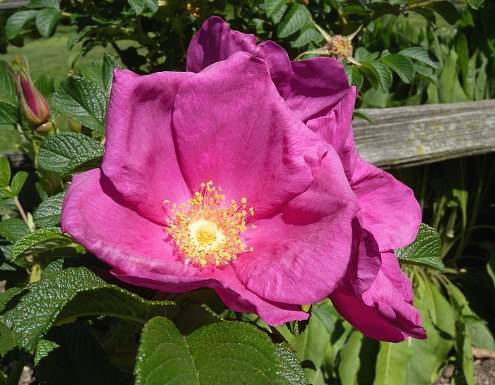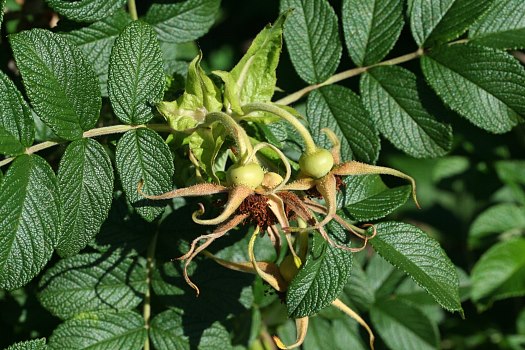Description: This wildflower is a branching woody shrub about 2-6' tall. Older branches are woody, brown, and glabrous, while young shoots are light green and densely hairy. Both branches and shoots are covered with straight prickles of varying lengths. Alternate compound leaves occur along young shoots; they are widely spreading and odd-pinnate with 5-9 leaflets. The leaflets are about 1-2½" long and about one-half as much across; they are oblong-ovate or oblong-obcordate, crenate-serrate along their margins, and rather thick-textured. The upper surfaces of the leaflets are dark green, hairless, shiny, and conspicuously wrinkled along their veins, while their lower surfaces are more whitish green from dense pubescence. The central stalk (rachis) of each compound leaf is light green and pubescent; its underside has small prickles.

The petiole of each
compound leaf is rather stout, light
green, and pubescent; at its base there is a pair of large lanceolate
stipules about 1" long and one-third as much across. Each stipule
tapers to a flared point. Upper shoots
occasionally produce either individual or small cymes of 2-5 flowers on
short branching peduncles. Individual flowers are 2-3½" across,
consisting of 5 petals, 5 sepals, a ring of numerous stamens, a
flat-topped cluster of pistils, and a light green base. The broad
rounded petals are widely spreading and often wrinkled; they are white,
pink, or magenta (more often the latter). The sepals are light green to
reddish green, linear-lanceolate, and glandular-pubescent. The blooming
period occurs during the summer for about 3 months. The flowers have a
strong fragrance that is typical of roses. The flowers are replaced by
subgloboid fruits (rose hips) about ¾-1¼" across that have persistent
sepals. These fruits are initially light green, but they eventually
become bright orange-red or red. Each fruit has a dry pulp
containing
several bony seeds. The root system is woody and branching, producing
vegetative offsets from underground runners.
Cultivation:
The preference is full to partial sun, moist to dry-mesic conditions,
and sandy soil. This shrub also adapts to fertile loam and other kinds
of soil. It is more tolerant of salt than most plants.
Range & Habitat:
While it is often cultivated, the non-native Rugosa Rose rarely
naturalizes in
Illinois. However, it may have some potential to become invasive in
sandy habitats, particularly near Lake Michigan. It may also adapt to
sandy roadsides where road salt is applied. Rugosa Rose is already
well-established in sandy areas along the Atlantic coast of New
England. In addition to its use as an ornamental plant, Rugosa Rose has
been used for erosion control along beaches and to help stabilize sand
dunes.
Faunal Association:
Only pollen is offered as a reward for flower-visiting insects. The
flowers of Rosa spp. (Roses) are cross-pollinated
primarily by various long-tongued bees, particularly bumblebees. One
bee species, Synhalonia rosae, is a
pollinator-specialist (oligolege) of roses. Other floral visitors
include Halictid bees and Syrphid flies. The bees collect pollen for
their larvae, while the flies feed on pollen. Some bees use roses as
nesting material; Megachile spp. (leaf-cutting
bees) use pieces of rose petals and leaves as partitions
in their nests, while Ceratina spp.
(little
carpenter bees) sometimes create nests within broken-off stems by
removing the pith. Other insects feed on various parts of rose bushes
more or less destructively. These insect feeders include leaf beetles,
scarab beetles, larvae of long-horned beetles, aphids, leafhoppers,
scale insects, larvae of gall wasps, larvae of sawflies, larvae of
moths, and flower thrips. Such insects as Metopolophium dirhodum (Rose-grass Aphid), Rhodobium porosum (Yellow Rose Aphid), Aulacaspis rosae (Rose Scale), and Diaspidiotus perniciosus (San Jose Scale) have been observed to feed on Rugosa Rose (Rosa rugosa) specifically. The Insect Table lists these and other insect feeders. Among vertebrate animals, rose hips are eaten by upland gamebirds and some songbirds;
this includes the Greater Prairie Chicken, Ruffed Grouse, Bobwhite
Quail, Cardinal, and others. The White-Footed Mouse and Deer Mouse also
eat rose hips and possibly the seeds. White-Tailed Deer and Cottontail
Rabbits browse on the leaves occasionally.
Photographic Location:
A garden at Meadowbrook Park in Urbana, Illinois.

Comments: Attractive foliage and fruit, fragrant flowers, and ease of cultivation are some of the attractive features of this rose. Some cultivars produce double flowers. Escape into the wild is always possible because birds and other animals eat the rose hips containing the seeds. The underground runners of this rose may survive earth-moving operations and establish new plants in other areas. Rugosa Rose is one of the easier rose species to identify because of its distinctive wrinkled leaves; other roses have leaves that are more smooth. Other distinctive characteristics of Rugosa Rose include unusually large rose hips (about 1" across), an abundance of straight prickles on its branches and shoots, and flowers with bright magenta petals that tend to be floppy and wrinkled. However, flowers with white or pink petals also occur.